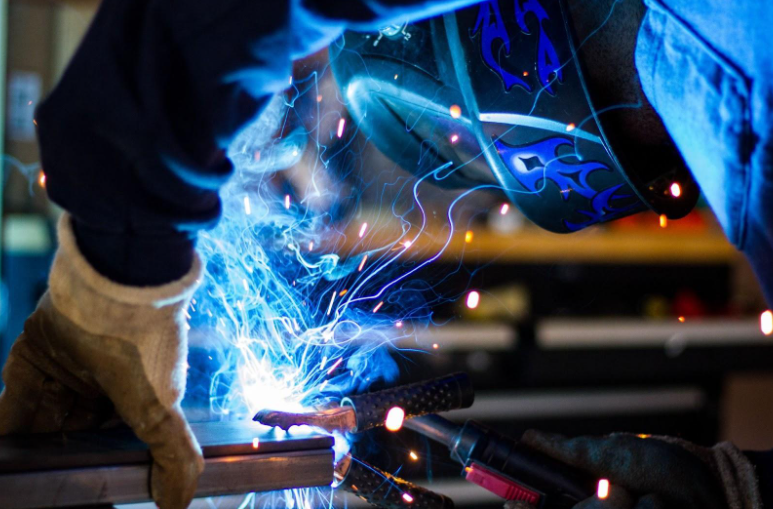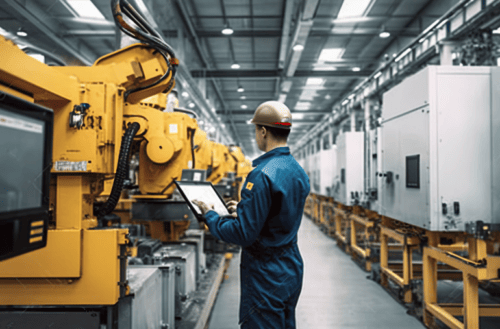Repetitive Manufacturing: Definition, Types, and Benefits

Technological advances have led to a higher quality of life for many individuals and efficiency gains for most businesses. However, there have been new challenges posed by technological advances, including pollution and waste.
In response, some companies are adopting a new technique called repetitive manufacturing. This manufacturing process is designed to help minimize waste while also reducing pollution. Let’s take an in-depth look at repetitive manufacturing.
What Is Repetitive Manufacturing?
Repetitive manufacturing is a production method involving the mass production of identical products, typically on a regular or continuous basis. Repetitive manufacturing is typically used for high-demand products and products with a stable production process.
The repetitive manufacturing production process is highly standardized and optimized for efficiency. It involves using assembly lines, automated machinery, and computer-controlled equipment to produce quickly and with minimal human intervention. The production process is also highly efficient, with minimal downtime and minimal variability in the final product.
Repetitive manufacturing uses a series of steps to produce a final product. This process uses specialized equipment and automation to bring precision and consistency to the production process.
This precision is essential for producing large quantities of identical products.
Characteristics of Repetitive Manufacturing
Repetitive manufacturing has many features that make it an efficient and cost-effective production method. Here are some of the elements of the repetitive manufacturing process.
Automation and Specialized Equipment
Repetitive manufacturing often employs automation and specialized equipment. This equipment includes robots, computer-controlled machines, and a production line designed to work together to produce finished goods.
Automation and specialized equipment allow repetitive manufacturing to adapt to new products and technologies introduced to the market, increasing the level of flexibility for firms using repetitive manufacturing. Technology also increases efficiency and precision in the production process, making it possible for the large-scale production of identical products.
Master Data
Repetitive manufacturing relies on accurate and up-to-date master data. Master data includes information about materials, components, and production processes. This data helps to plan and schedule production processes and to ensure that suitable materials and parts are available when needed to support the production schedule.
Schedule Tables
Repetitive manufacturing uses a master production schedule to plan and organize production processes. These tables include information about the expected demand for a product, the lead time for production, and the capacity of the manufacturing facility.
The information assists in determining production planning and ensuring that the right products are produced at the right time to meet demand.
Sequencing
Sequencing is an essential component of the repetitive manufacturing process. It refers to organizing and scheduling the production version of different products in a specific order. Sequencing ensures that the right products get produced at the right time and that the process manufacturing facility operates efficiently.
Standardization
Standardization refers to the establishment and maintenance of consistent and uniform standards for a specific product, process, or service. Repetitive manufacturing uses standard operating procedures (SOPs) and work instructions. It ensures that the process is consistent and that each product meets the same high standards.
Standardization involves using common materials and components, allowing for easy replacement and maintenance of parts. It allows for economies of scale in the procurement of materials and components. The process also reduces the need for training and supervision of machines and equipment.
Quality Control

Quality control is essential to ensuring that each product meets the same high standards. Repetitive manufacturing places a strong emphasis on quality control and assurance, including inspection and testing products at various stages of the production process to ensure that required specifications and standards are met consistently.
Quality control also includes continuous production process improvement, using data collection and analysis to optimize the production process and reduce costs. It includes identifying and eliminating sources of variability and defects and implementing corrective and preventive actions to improve the overall process.
Data Collection and Analysis
Data collection and analysis are vital aspects of repetitive manufacturing processes. They allow for continuous improvement of the production process by identifying and eliminating sources of variability and defects. Data collection and analysis can also be used to implement corrective and preventive actions to improve the overall process.
Using data collection and analysis helps optimize production lines and reduce costs. It also allows for real-time monitoring and control of the production process.
The Two Types of Repetitive Manufacturing
There are two types of repetitive manufacturing in production companies. The distinction between these types is by the time of production and stock held. They include make-to-order (MTO) and make-to-stock (MTS).
Make-to-order is repetitive manufacturing in which products are manufactured based on a customer’s order. This type of process manufacturing works for customized products to meet individual customers’ needs.
MTO allows for a high degree of flexibility since it follows a production order. However, this flexibility comes at a cost, as it requires a longer lead time for production and may have higher production costs due to the customization work required.
Order-based production work in an industry that produces unique or customized products, such as personalized cars or specialized machinery. This type of manufacturing also works in industries that have products with low demand but require high customization.
MTS manufacturing is used for products with high demand and a predictable sales pattern. In MTS, production is based on forecasted demand and structured to meet the expected demand on time. This type of manufacturing incorporates high efficiency and low production costs.
Industries producing products with high demand and a predictable sales pattern use MTS process manufacturing. The use of specialized equipment and automation is common in this manufacturing flow, allowing for high-speed and efficient production.
Additionally, MTS consists of high efficiency and low production costs because the production process is highly standardized and optimized for efficiency. Inventory in MTS is kept in stock to meet the expected demand. If the order is higher than expected, production can be scaled accordingly.
Benefits of Repetitive Manufacturing
A repetitive manufacturing process offers a lot of benefits to the entire value chain. Let’s look at some of the advantages of repetitive manufacturing.
Cost-Effectiveness
Repetitive manufacturing offers cost-effectiveness by minimizing production costs and waste and continuously improving the production process. It includes specialized equipment, automation, and efficient production methods. This cost reduction can result in lower prices for customers and increased profitability for the manufacturer.
Additionally, using the same types of materials and components allows for economies of scale in procuring materials and components, resulting in lower costs. A product cost collector could also help manufacturers track and analyze the costs associated with producing a specific product line.
Performance Visibility
Performance visibility is an advantage of repetitive manufacturing because it offers real-time monitoring and control of the production process. It enables manufacturers to quickly identify and correct any issues that arise, improving the overall efficiency of the production process.
Performance visibility also allows manufacturers to track key performance indicators (KPIs) such as production output, quality, and efficiency. By monitoring these KPIs, manufacturers can make data-driven decisions to optimize the production process, improve product quality, and increase the production rate.
Flexibility
The repetitive manufacturing method enables manufacturers to adapt to changing market conditions and customer needs. Companies can quickly and efficiently introduce new products or modify existing ones. They can also adjust production lines based on changes in demand and continuously improve the production process through data collection and analysis.
Standardization
Repetitive manufacturing is designed for standardization, resulting in efficient and consistent production rates of identical products. It includes using specialized machines and assembly lines designed to work together, standard operating procedures and work instructions, and the same materials and components.
Continuous Improvement
Repetitive manufacturing uses data collection and analysis to optimize production and reduce costs and drive continuous improvement. Achieving continuous improvement involves identifying and eliminating sources of variability and defects and implementing corrective and preventive actions to improve the overall process.
Repetitive Manufacturing Challenges
Repetitive manufacturing is a good approach for many products but it is limited in the types of industries that can use repetitive manufacturing. These are some of the limitations of repetitive manufacturing.
Lack of Personalization
If there is a need to personalize products to meet individual customer needs, repetitive manufacturing does not offer this level of customization because it is intended to create large quantities of identical products.
Lack of Flexibility When Demand Does Not Match Forecasts
Repetitive manufacturing works based on predictable demand. There are situations in which actual demand may be different from the forecasted demand. This forecasting can lead to fewer products being manufactured, which could ultimately lead to stockouts, lost sales, and disappointed customers
Limited Creativity
Repetitive manufacturing has a fixed production process and allows very little room for experimentation or change due to the requirement for standardization. Standardization and automation require high consistency and predictability in the production process. These requirements limit the ability to test new designs, features, or materials in production.
FAQs
Here are some frequently asked questions about repetitive manufacturing
What is a repetitive process example?
The repetitive process is a module-based, product-focused production method. Modules are pieces or elements of a product that have already been produced or processed, frequently as part of an ongoing process.
An example of a repeated process employing modules is the production of automobiles. In this instance, different stages of the car assembly are performed by specialized teams working on a specific part of the car, such as the engine, transmission, or body assembly.
What is the difference between discrete and repetitive production?
Discrete manufacturing is a manufacturing process that produces unique, one-of-a-kind products. The production process is flexible and adaptable and involves more customization and manual labor.
However, repetitive production involves the mass production of identical products. The production process is highly standardized and automated and focuses on efficiency and consistency. The demand for the product is predictable, and the production process meets that demand.
Final Thoughts
Repetitive manufacturing is cost-effective when the product demand is consistent and predictable. The production process and tools are highly standardized and often have low costs.
Repetitive manufacturing could be a good solution for any company seeking an efficient and productive way to make and sell products.
